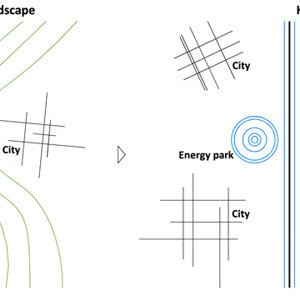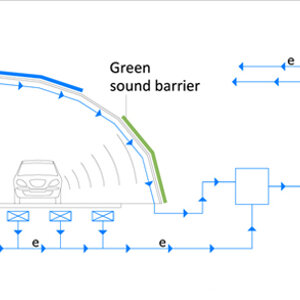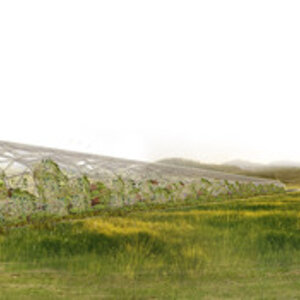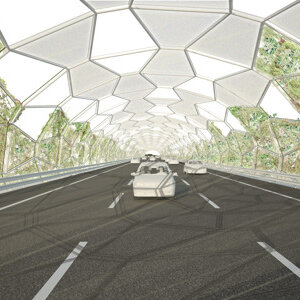Follow us on:
Contacts:
Via Fra Mauro 14b
00176, Roma
Italia
00176
https://www.iubenda.com/privacy-policy/14663859
High Energy Way





Design team: Giuliana SIbilia, Giuseppe Vultaggio
Structural engineer: GIanluca Vultaggio
High Energy way is an energy self-sufficient highway system. It is a modular tunnel - flexible in length - consisting of progressive bands that use a range of different renewable energy technologies. At the urban scale, High Energy way is a connecting element between several energy parks located along the territory.
The project aims to provide a transportation network technologically advanced, and integrated into the landscape, at the same time. The tunnel is made up of a steel grid structure: it provides support for the layer of plants that cover the tunnel. This green skin not only acts like a sound barrier - protecting the surrounding landscape from vehicle noise pollution -, but it also allows the highway to blend in with the landscape. For this reason, varieties of vigorous evergreen climbing plants, such as Hedera Helix, Jasminum Officinale Aureum and Trachelosperum Jasminoides, were chosen.
Two technological systems are used to produce energy. The main source of energy supply is provided by solar panels, located on the top of the steel structure. In addition to solar energy, vehicles produce mechanical energy due to their motion. The energy is obtained by using a technological system based on converting energy from weight, motion, vibration, and temperature changes occurring in a piezoelectric material when vehicles passing over it cause tensions and mechanical deformations. Thanks to the installation of piezoelectric generators 5 cm below the asphalt level, this system produces 150 kW of electricity per 1 km of highway and 500 kW of electricity connecting that 1 km long highway to the local power grid. The electricity produced can be used in a number of applications: from fixtures to buildings, from lighting to back-up systems, from road signs to electrical devices.
__
High Energy way è un sistema di mobilità autonomo dal punto di vista energetico. E’ un tunnel modulare, di lunghezza variabile, in bande progressive dotate di tecnologie differenti per produrre energia verde. A scala urbana, è un elemento di connessione tra i numerosi parchi energetici dislocati lungo il territorio.
Obiettivo del progetto è fornire una rete infrastrutturale tecnologicamente avanzata, al contempo integrata nel paesaggio. Il tunnel è costituito da una struttura reticolare in acciaio, supporto per il rivestimento esterno di vegetazione. La pelle verde non solo agisce come barriera sonora, proteggendo i territori circostanti dall’inquinamento acustico veicolare, ma contribuisce anche all’inserimento mimetico dell’infrastruttura nel paesaggio. A questo scopo, sono state scelte varietà di piante rampicanti resistenti e sempreverdi, quali l’Hedera Helix, il Jasminum Officinale Aureum e il Trachelosperum Jasminoides.
Due i sistemi applicati per la produzione di energia. Fonte principale di approvvigionamento energetico sono i pannelli solari, posti sulla sommità della struttura. A questi si aggiunge l’energia meccanica prodotta dai veicoli in movimento. Questa è ottenuta utilizzando una tecnologia basata sulla conversione di energia da variazioni di peso, movimento, vibrazione e temperatura in un materiale piezoelettrico, quando passando su di esso, i veicoli provocano tensioni e deformazioni meccaniche. Installando generatori piezoelettrici 5 cm sotto l’asfalto, il sistema è in grado di produrre 150 kW di elettricità per 1 km di autostrada e 500 kW di elettricità connettendo quel tratto di strada alla rete elettrica locale. L’energia prodotta trova possibilità di applicazione in numerosi ambiti: dagli impianti agli edifici, dall’illuminazione ai sistemi di back-up, dalla segnaletica stradale ai dispositivi elettrici.
Follow us on:
Contacts:
Via Fra Mauro 14b
00176, Roma
Italia
00176
https://www.iubenda.com/privacy-policy/14663859

